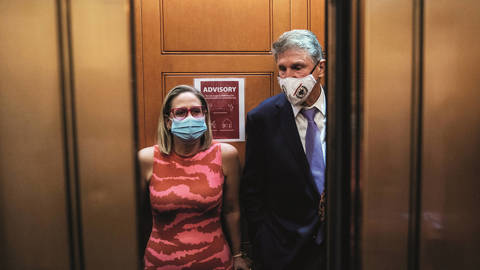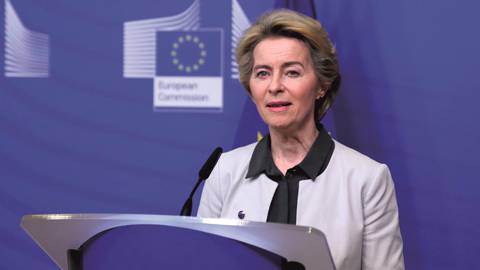The year ahead will be defined by three main challenges: rising macroeconomic risks, climate change, and the digital disruption. Multilateral institutions have an important role to play, but so does the private sector.
LONDON – As 2021 ends, the global economy is being forced to adapt to significantly changed conditions. It will not be a quick or painless process. The world is facing major disturbances caused by disrupted trade links, soaring energy prices, and labor-market mismatches. While many retailers have closed their brick-and-mortar stores, driving up unemployment, there have been significant shortages of information-technology engineers and truck drivers.
Many of these changes have been caused – or accelerated – by the COVID-19 crisis. But make no mistake: there is no going back to the pre-pandemic normal. The crisis will bring deep and long-lasting change. As we look to the year ahead, we must prepare to cope with three main challenges.
Rising Macroeconomic Risks
Among the biggest questions for the months ahead will be whether we are entering a new era of inflation, and how to manage high levels of public and private debt. Over the course of 2020, in many economies where the European Bank for Reconstruction and Development (EBRD) operates, public debt rose to levels last seen in the early 1990s. In some countries, it reached historic highs. A lack of fiscal and monetary space – together with barriers to vaccine access and negative spillovers from the advanced economies – could increase the divergence between emerging and developing countries.
Action by national governments – from mobilizing finance for economic-support packages to organizing mass vaccination campaigns – has been indispensable to the pandemic response. And, to end the crisis, trust in public-health programs, and in the safety and effectiveness of COVID-19 vaccines, will be as important as the vaccines themselves.
Yet, to return to sustainable growth and long-term fiscal sustainability, we will have to unleash the productive power of entrepreneurship. Here, the private sector will have to play a crucial role.
The Climate Challenge
The pandemic highlighted the vulnerability – though also the resilience – of our global economic order. It can be viewed as a stark reminder of the intensifying dangers of non-economic factors caused or exacerbated by climate change. According to the latest report from the Intergovernmental Panel on Climate Change, global warming is set to reach or exceed 1.5° Celsius, relative to pre-industrial levels, over the next 20 years. This will have a number of consequences, including more frequent and intense extreme weather – heat waves, storms, droughts, and other destructive events – and longer warm seasons.
The transition to net-zero emissions is not merely an ideal goal; it is a necessity. The faster countries manage this transition, the more competitive they will remain, and the fewer social and economic disruptions they will experience.
To this end, it will be essential to mobilize private finance. Per our new strategy, the EBRD is working to double our climate-finance resources by 2025; we expect that private resources will also double. Moreover, green financing will account for more than 50% of our annual business volume by 2025. And, starting in 2023, all of our operations will be aligned with the goals set out in the Paris climate agreement.
In the fight against climate change, we must rely on proven market mechanisms, such as carbon pricing. Markets must be well regulated, but regulators must not stifle the private sector’s capacity for innovation or appetite for risk. Likewise, they must not impede the efficient use of resources – which benefits both the environment and economic growth. It is the private sector that knows how to generate the needed productivity gains.
Technological advances offer hope for real progress toward meeting the Paris agreement’s goals. But that progress will come at a price. The green transition must not repeat the mistakes of recent decades, when trade and financial globalization left many behind.
Effective responses to whole-of-society challenges will require whole-of-society buy-in. The more fractured and polarized we are, the more difficult it will be to devise and implement solutions. In recent years, we have seen the political consequences of rising inequality and polarization. Voters who cannot earn a living and provide for their families vote like they have nothing to lose.
The green transition can succeed only if it is a just transition. Provisions to support those whose livelihoods are hit hardest during the transformation are thus essential. In the short term, direct financial support must be part of the equation. In the medium and long term, the provision of quality, ongoing education and desirable work opportunities, regardless of background or gender, must be top priorities.
The Digital Disruption
The rapid digitalization of the economy demands a similar approach. Pandemic lockdowns have accelerated irreversible trends in the workplace and the wider economy, such as broad acceptance of work-from-home arrangements, adoption of artificial intelligence on a sharply increasing scale, and the widespread embrace of e-banking. An average of 96% of advanced-economy consumers now use digital payment methods.
And the transformation of banking, retail, and many other sectors has only just begun. Smart grids and smart meters, for example, are set to make a massive contribution to improving the use of scarce resources. They will underpin the smart cities of the future.
Ensuring that promising technological innovations are developed and implemented responsibly requires a strong, competitive, and transparent regulatory framework. And it demands broad access to technology services. Evidence gathered by EBRD economists shows that the COVID-19 crisis has widened the digital divide. This is an area where an investor like the EBRD can intervene. And that is exactly what we intend to do.
Political Dynamics and the Role of Multilateralism
Rising geopolitical tensions and the spread of populism poses a serious challenge to the economic models and core values of Western democracies, and to multilateralism. Against this backdrop, multilateral institutions must – and can – play a moderating role.
The grave, persistent difficulties that low-income countries have faced in obtaining COVID-19 vaccines show how difficult it is to ensure equality and fairness at a global level. But the agreement this year on a global minimum corporate-tax rate is proof that multilateralism can deliver. The rapid provision of liquidity to struggling countries during the pandemic further highlights the power of multilateralism. With record investment of €11 billion ($12.7 billion) in 2020, the EBRD was able to make an important contribution here.
The pandemic has also shown that multilateral development institutions with a capacity to drive policy reform, like the EBRD, can help to create conditions for private-sector investment. This will be vital to restore dynamism to development after COVID-19.
Robust, sustainable, and inclusive growth is the goal all multilateral institutions now share. Together with our partners, we at the EBRD are securing the economic riverbed. But it is the market that will form the current driving recovery and development.






LONDON – As 2021 ends, the global economy is being forced to adapt to significantly changed conditions. It will not be a quick or painless process. The world is facing major disturbances caused by disrupted trade links, soaring energy prices, and labor-market mismatches. While many retailers have closed their brick-and-mortar stores, driving up unemployment, there have been significant shortages of information-technology engineers and truck drivers.
Many of these changes have been caused – or accelerated – by the COVID-19 crisis. But make no mistake: there is no going back to the pre-pandemic normal. The crisis will bring deep and long-lasting change. As we look to the year ahead, we must prepare to cope with three main challenges.
Rising Macroeconomic Risks
Among the biggest questions for the months ahead will be whether we are entering a new era of inflation, and how to manage high levels of public and private debt. Over the course of 2020, in many economies where the European Bank for Reconstruction and Development (EBRD) operates, public debt rose to levels last seen in the early 1990s. In some countries, it reached historic highs. A lack of fiscal and monetary space – together with barriers to vaccine access and negative spillovers from the advanced economies – could increase the divergence between emerging and developing countries.
Action by national governments – from mobilizing finance for economic-support packages to organizing mass vaccination campaigns – has been indispensable to the pandemic response. And, to end the crisis, trust in public-health programs, and in the safety and effectiveness of COVID-19 vaccines, will be as important as the vaccines themselves.
Yet, to return to sustainable growth and long-term fiscal sustainability, we will have to unleash the productive power of entrepreneurship. Here, the private sector will have to play a crucial role.
The Climate Challenge
The pandemic highlighted the vulnerability – though also the resilience – of our global economic order. It can be viewed as a stark reminder of the intensifying dangers of non-economic factors caused or exacerbated by climate change. According to the latest report from the Intergovernmental Panel on Climate Change, global warming is set to reach or exceed 1.5° Celsius, relative to pre-industrial levels, over the next 20 years. This will have a number of consequences, including more frequent and intense extreme weather – heat waves, storms, droughts, and other destructive events – and longer warm seasons.
SPRING SALE: Save 40% on all new Digital or Digital Plus subscriptions
Subscribe now to gain greater access to Project Syndicate – including every commentary and our entire On Point suite of subscriber-exclusive content – starting at just $49.99.
Subscribe Now
The transition to net-zero emissions is not merely an ideal goal; it is a necessity. The faster countries manage this transition, the more competitive they will remain, and the fewer social and economic disruptions they will experience.
To this end, it will be essential to mobilize private finance. Per our new strategy, the EBRD is working to double our climate-finance resources by 2025; we expect that private resources will also double. Moreover, green financing will account for more than 50% of our annual business volume by 2025. And, starting in 2023, all of our operations will be aligned with the goals set out in the Paris climate agreement.
In the fight against climate change, we must rely on proven market mechanisms, such as carbon pricing. Markets must be well regulated, but regulators must not stifle the private sector’s capacity for innovation or appetite for risk. Likewise, they must not impede the efficient use of resources – which benefits both the environment and economic growth. It is the private sector that knows how to generate the needed productivity gains.
Technological advances offer hope for real progress toward meeting the Paris agreement’s goals. But that progress will come at a price. The green transition must not repeat the mistakes of recent decades, when trade and financial globalization left many behind.
Effective responses to whole-of-society challenges will require whole-of-society buy-in. The more fractured and polarized we are, the more difficult it will be to devise and implement solutions. In recent years, we have seen the political consequences of rising inequality and polarization. Voters who cannot earn a living and provide for their families vote like they have nothing to lose.
The green transition can succeed only if it is a just transition. Provisions to support those whose livelihoods are hit hardest during the transformation are thus essential. In the short term, direct financial support must be part of the equation. In the medium and long term, the provision of quality, ongoing education and desirable work opportunities, regardless of background or gender, must be top priorities.
The Digital Disruption
The rapid digitalization of the economy demands a similar approach. Pandemic lockdowns have accelerated irreversible trends in the workplace and the wider economy, such as broad acceptance of work-from-home arrangements, adoption of artificial intelligence on a sharply increasing scale, and the widespread embrace of e-banking. An average of 96% of advanced-economy consumers now use digital payment methods.
And the transformation of banking, retail, and many other sectors has only just begun. Smart grids and smart meters, for example, are set to make a massive contribution to improving the use of scarce resources. They will underpin the smart cities of the future.
Ensuring that promising technological innovations are developed and implemented responsibly requires a strong, competitive, and transparent regulatory framework. And it demands broad access to technology services. Evidence gathered by EBRD economists shows that the COVID-19 crisis has widened the digital divide. This is an area where an investor like the EBRD can intervene. And that is exactly what we intend to do.
Political Dynamics and the Role of Multilateralism
Rising geopolitical tensions and the spread of populism poses a serious challenge to the economic models and core values of Western democracies, and to multilateralism. Against this backdrop, multilateral institutions must – and can – play a moderating role.
The grave, persistent difficulties that low-income countries have faced in obtaining COVID-19 vaccines show how difficult it is to ensure equality and fairness at a global level. But the agreement this year on a global minimum corporate-tax rate is proof that multilateralism can deliver. The rapid provision of liquidity to struggling countries during the pandemic further highlights the power of multilateralism. With record investment of €11 billion ($12.7 billion) in 2020, the EBRD was able to make an important contribution here.
The pandemic has also shown that multilateral development institutions with a capacity to drive policy reform, like the EBRD, can help to create conditions for private-sector investment. This will be vital to restore dynamism to development after COVID-19.
Robust, sustainable, and inclusive growth is the goal all multilateral institutions now share. Together with our partners, we at the EBRD are securing the economic riverbed. But it is the market that will form the current driving recovery and development.